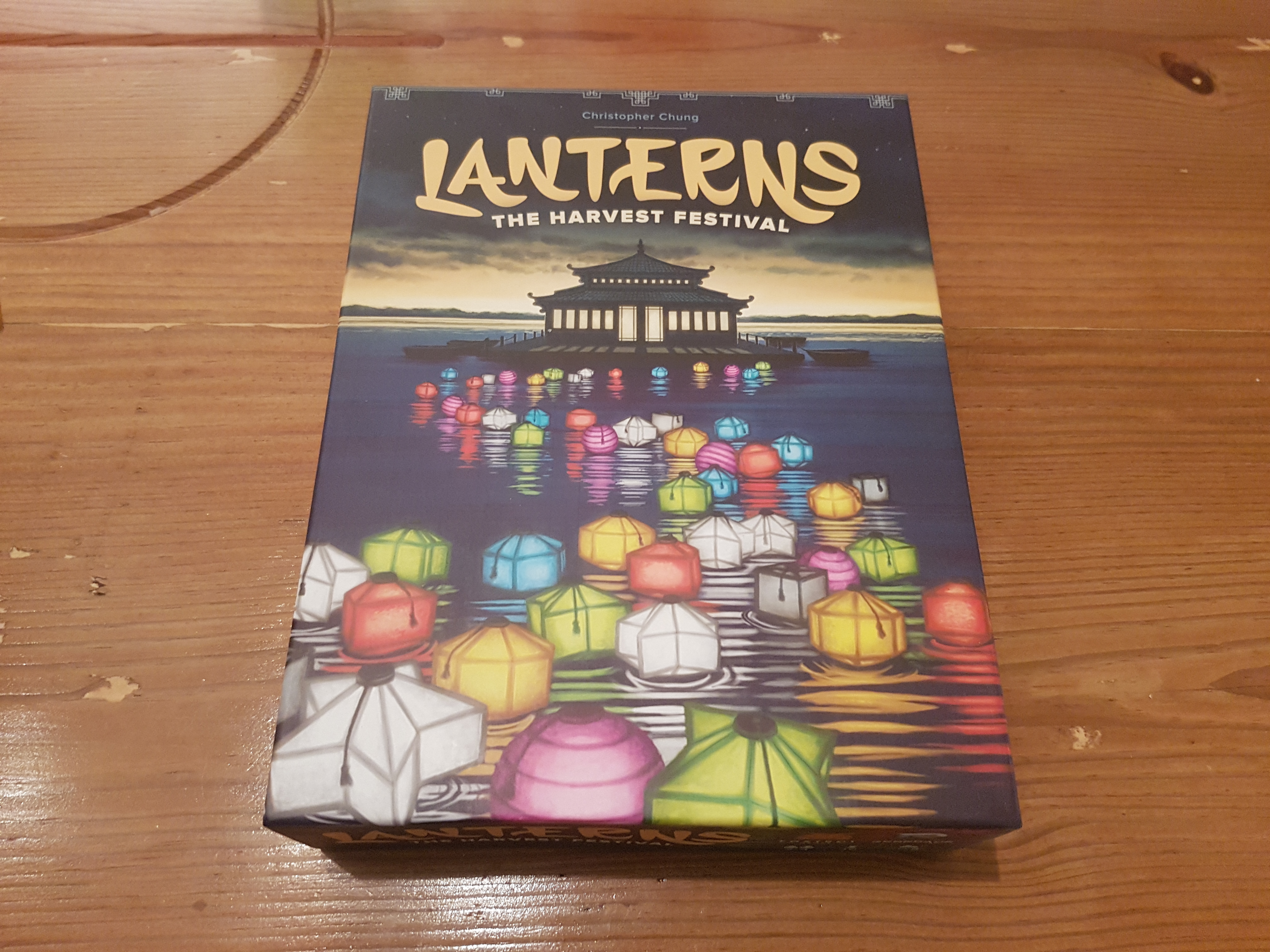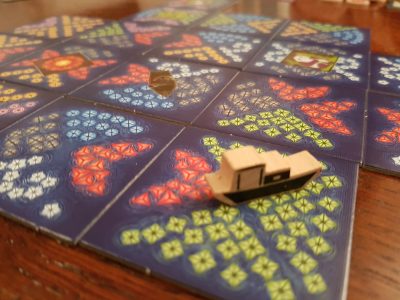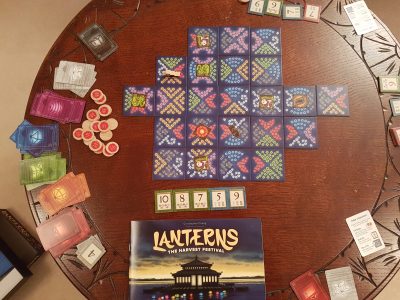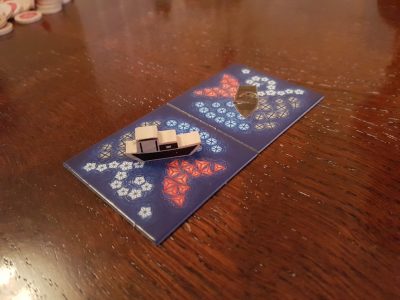Lanterns: The Harvest Festival, released back in 2015, is a set collection and tile placement board game from designer Christopher Chung. Published by Foxtrot Games and Renegade Game Studios the title sees 2 – 4 players become artisans before an upcoming festival. The game lasts around 30 minutes, in that time artisans will have floated lanterns and platforms across a lake. This is all done to become the most honoured artisan in time for the start of the festival. Does Lanterns: The Harvest Festival float above the rest of tile placement games? Let’s find out!
To start the game off the starting tile is placed in the centre of the table. Next up, colourful lantern cards, lake tiles and scoring tokens are piled to one side and each player receives a hand of 3 lake tiles. The starting tile must be orientated with flat edges towards players. Everyone gets a coloured lantern card, depending on the colour of lanterns facing them on the starting tile. From here the game is then ready to go.
On a turn an artisan can perform 3 defined actions, two optional and one mandatory. These are performed in a set order: Exchange a lantern card, make a dedication and then place a tile. Unfortunately, for explanation purposes they are in a rather backwards order, so we shall start with the mandatory third action, which each player must take, placing a tile.
When placing a lake tile the only limitation is it must be adjacent to an already placed tile. If the side of the newly placed tile matches in colour with the lanterns it is adjacent to then the placer gets a lantern card of that colour, if one is available. Once placed, in a similar way to the starting tile, going around the table starting from the active player, each player gains a lantern card of the colour facing them on the placed tile. On top of a lantern card if either the new tile or the connected-to tile(s) feature a floating platform a favour token is awarded.
After placing a lake tile a new one is drawn from the draw pile and play moves onto the next player. The first few rounds will see only tile placement until some favour tokens and lantern cards have been earnt. Then, the first optional action of exchange may be performed. This sees the player discard any coloured lantern card and two favour tokens to gain a lantern card of any colour. This is ideal for getting the coloured lantern card you need… but how do you use them?
Lanterns is all about trading in sets of colourful lantern cards for points, or in lore terms making a dedication. In the order of actions, this second optional action allows a player to trade in cards to gain point scoring tokens. The combinations required are 4 of a kind, 3 pairs or 1 of all 7 colours. These may sound like a lot of cards (4, 6 and 7 respectively) but the number of cards earnt throughout the game is incredibly high. When trading lantern cards in the top point token of that type is taken. Each time a type of token is claimed the points value for future identical dedications drops, so getting the first of a type can be beneficial.
As there are three different methods for scoring players will often be working towards different objectives, though there is the potential to react when point tokens are taken or lantern cards are awarded. Play continues going around the table until all the tiles have been placed. At this point each player gets one last turn to perform the two optional actions of exchange and dedicate. Everyone then adds up the points earnt from the dedication tokens and the player with the most points is crowed as the winning artisan.
In a similar way to Carcassonne the way the map grows as the game progresses results in an elegant and stunning visual experience. The individual tiles don’t look like much, despite being colourful. Once combined into a large lake of floating lanterns it becomes more than the sum of its parts. The game revolves around these tiles so it is nice to see that a decent quality cardboard has been used, so over the lifetime of the game they should remain consistently robust and striking. The high production value doesn’t stop there with wooden favour tokens and vibrant colourful lantern cards. Each is another part of the colourful presentation that draws players in.
As with any tile placement and pattern matching game, Lanterns can fall a bit flat if players take too much time over turns. Analysis paralysis is certainly an entertainment killer. Even though the choices aren’t overly huge, some players can spend an age trying to determine the optimal placement of each and every tile. The more this happens the further from the fast-enjoyable tile placement game Lanterns becomes. Including a sand timer, or equivalent, may be overkill but would certainly stop the game being consistently slowed down.
With only 3 actions and 3 ways to score the game is easy to teach, allowing it to be extremely accessible to entry level gamers. Despite this ease of learning, Lanterns has enough to it from the pattern matching puzzle to keep players interested throughout the game. Some will find the game a tad too simplistic and this is partially due to gaining cards when it isn’t your turn. These players would argue that the mechanic creates gameplay where no skill is needed and feels almost random. To some extent it is until players start to truly invest thoughts into the game. From here placing tiles becomes incredibly important as you can make sure tiles reward you with exactly what you need while not helping others to gain the final colour card they require. This is extended when a colour runs out, making opponents draw this colour gains them no benefit and puts them behind.
Lanterns: The Harvest Festival is a game that both grows on the table and on players. Comparisons to Carcassonne are instantly drawn but this doesn’t do the game justice, as it is a very different take on the tile placement genre due to the scoring mechanisms. Once people have got past this they open themselves up to the potential of Lanterns and the enjoyment floats to the top. The game is simple to play and the visual appeal will only go hand in hand with this making it an ideal gateway title. For those looking for a meaty game Lanterns may not be for you, but for the fast-paced nature and beauty it has certainly earnt its spot on my board game shelf!
[Editor’s Note: Lanterns: The Harvest Festival was provided to us by Asmodee UK for review purposes. The game is currently available on 365 Games for £22.99. It is also available from local UK board game stores, find your local store here]




